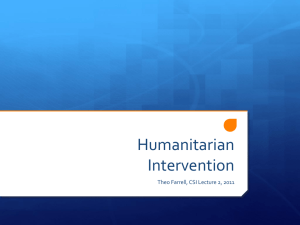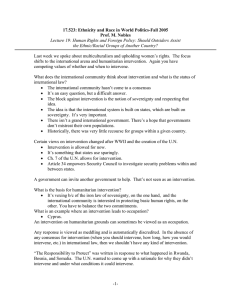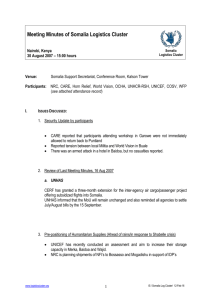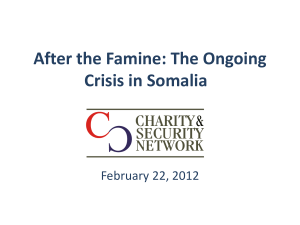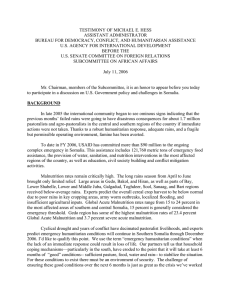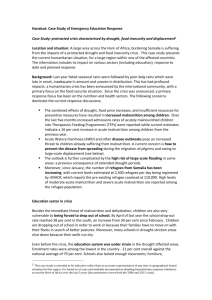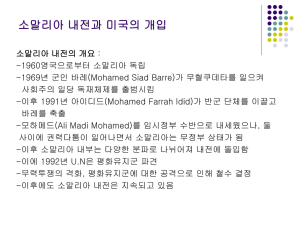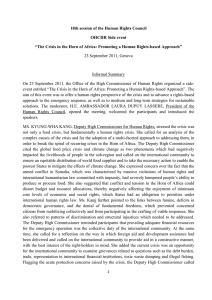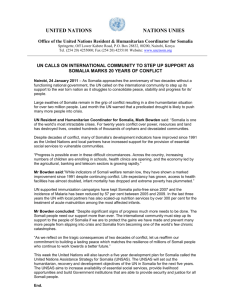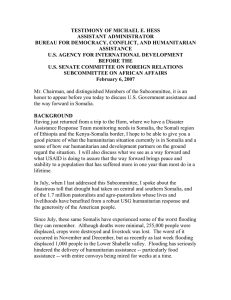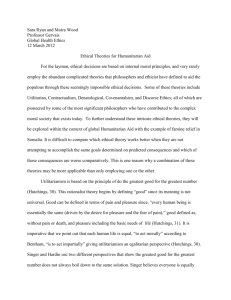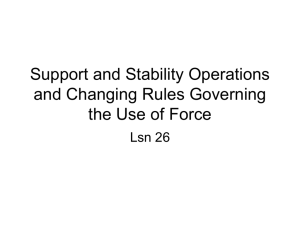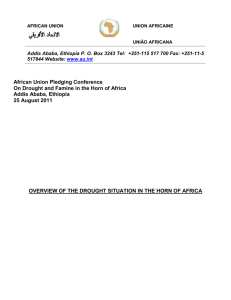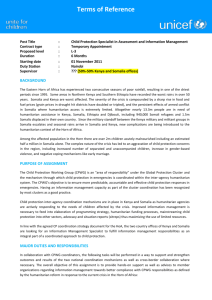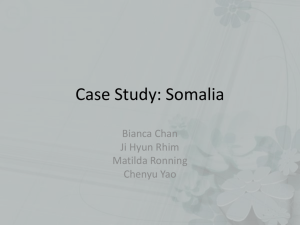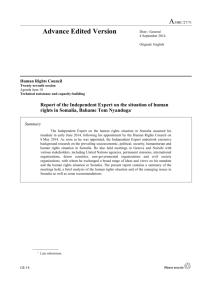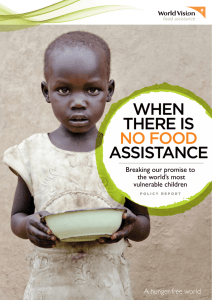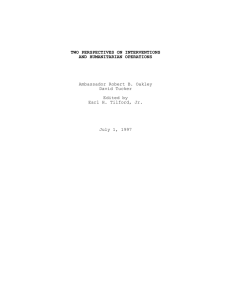WFP ED Sheeran`s prepared remarks for HoA mini summit
advertisement
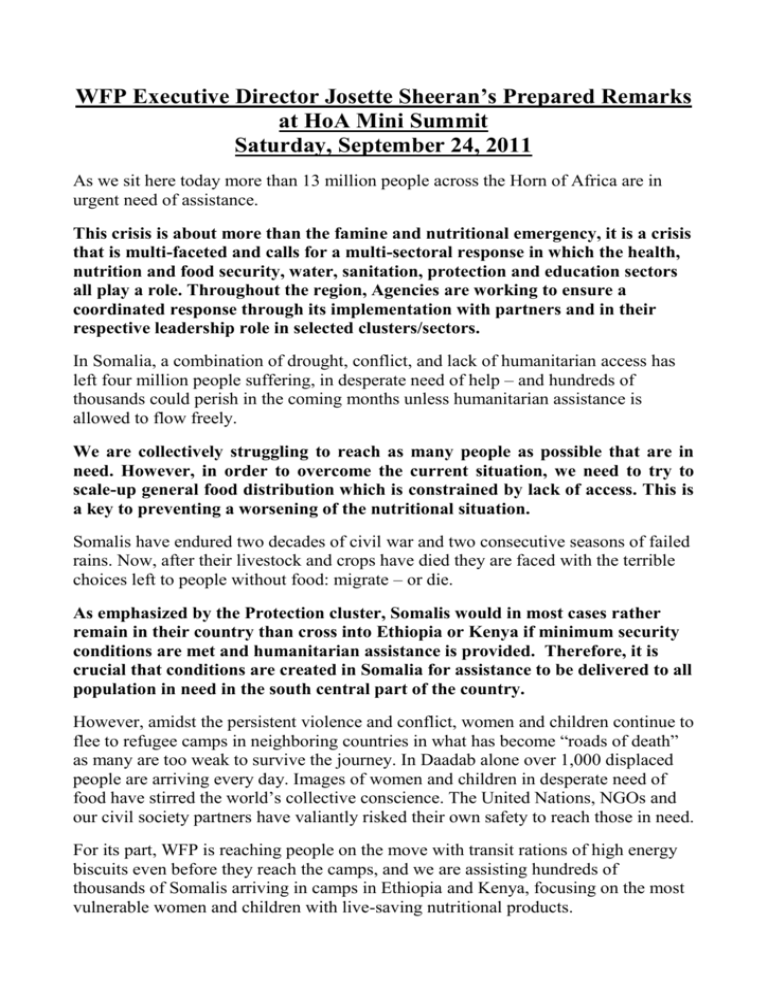
WFP Executive Director Josette Sheeran’s Prepared Remarks at HoA Mini Summit Saturday, September 24, 2011 As we sit here today more than 13 million people across the Horn of Africa are in urgent need of assistance. This crisis is about more than the famine and nutritional emergency, it is a crisis that is multi-faceted and calls for a multi-sectoral response in which the health, nutrition and food security, water, sanitation, protection and education sectors all play a role. Throughout the region, Agencies are working to ensure a coordinated response through its implementation with partners and in their respective leadership role in selected clusters/sectors. In Somalia, a combination of drought, conflict, and lack of humanitarian access has left four million people suffering, in desperate need of help – and hundreds of thousands could perish in the coming months unless humanitarian assistance is allowed to flow freely. We are collectively struggling to reach as many people as possible that are in need. However, in order to overcome the current situation, we need to try to scale-up general food distribution which is constrained by lack of access. This is a key to preventing a worsening of the nutritional situation. Somalis have endured two decades of civil war and two consecutive seasons of failed rains. Now, after their livestock and crops have died they are faced with the terrible choices left to people without food: migrate – or die. As emphasized by the Protection cluster, Somalis would in most cases rather remain in their country than cross into Ethiopia or Kenya if minimum security conditions are met and humanitarian assistance is provided. Therefore, it is crucial that conditions are created in Somalia for assistance to be delivered to all population in need in the south central part of the country. However, amidst the persistent violence and conflict, women and children continue to flee to refugee camps in neighboring countries in what has become “roads of death” as many are too weak to survive the journey. In Daadab alone over 1,000 displaced people are arriving every day. Images of women and children in desperate need of food have stirred the world’s collective conscience. The United Nations, NGOs and our civil society partners have valiantly risked their own safety to reach those in need. For its part, WFP is reaching people on the move with transit rations of high energy biscuits even before they reach the camps, and we are assisting hundreds of thousands of Somalis arriving in camps in Ethiopia and Kenya, focusing on the most vulnerable women and children with live-saving nutritional products. There has been an unprecedented global response to the crisis in the Horn of Africa. This outpouring of support has meant that new and committed organizations have come to assist in responding to the crisis. To maximize our coverage, particularly in southern Somalia, we need to forge partnerships with new humanitarian actors and work on building the capacity of more partners, which include local Somali organizations to deliver and report on humanitarian assistance. The clusters are already proving a valuable vehicle for pursuing this approach. The Food Cluster is coordinating with non-traditional and new organizations to enhance the ramping up of activities in areas where access is an issue and the scale of the crisis is greatest. Participation in the Food Cluster over the last weeks has grown to over 60 organizations, about half of which have or plan to initiate food assistance programs in Somalia. But despite the best efforts of governments, the humanitarian community, the significant resources from a broad-base of donors, including the private sector, and all the combined work of multi-sector partners in the food cluster, famine conditions are spreading. And unless there is a sudden and unforeseen change in the security environment, the coming weeks will see a worsening of the situation. Humanitarian supply lines remain highly vulnerable to looting, attack and theft by armed groups. With parties preventing humanitarian workers access to a population affected by famine conditions; abduction of NGO aid workers; and rampant lawlessness throughout Somalia, the task of reaching the most vulnerable populations remains monumental. With a consequent deterioration of the overall security, and the predicted arrival of the Deyr rains in October, the likelihood of increasing numbers of cases of cholera, measles and malaria on a population already weakened by famine, could be catastrophic. Malnutrition increases not only the risk of contracting infectious diseases, but also disease severity and therefore the risk of death. This, along with poor health and immunization status in drought-affected areas, limited access to food, water, shelter and sanitation, overcrowding in camps and the stress of displacement, put affected populations at high risk of contracting – and subsequently dying from – infectious diseases. In the coming rainy season, the population, already weakened by malnutrition, will face an increased risk both from malaria and other vector borne diseases (e.g. rift valley fever) and communicable diseases such as diarrhoeal diseases and typhoid. Across the Horn of Africa region, sadly, the areas most affected by the drought are those with the highest disease burden (diarrhoeal diseases, measles, malaria, meningitis) and the weakest health care systems. The Health Cluster response activities have focused on preventing and controlling communicable diseases, including through the strengthening of early warning and response systems for epidemic-prone diseases; providing medicines, medical supplies and technical assistance in order to support basic health care services, including immunization campaigns and mobile clinics in the drought-affected areas; supporting the management of severe acute malnutrition with medical complications through re-enforced stabilization centres in referral hospitals and therapeutic feeding centres. In Somalia, the response requires a rapid and massive scale up of the on-going humanitarian operation in Central/South Somalia where there is an extremely challenging operating environment for all programme areas. As a priority, we need to find comprehensive solutions to be able to significantly scale up food distribution in South Central Somalia while at the same time increasing ongoing efforts to treat acute malnutrition. This is going to require innovative solutions in the face of this highly complex emergency and operating environment. 450,000 children under five are acutely malnourished (combination of moderate and severely malnourished). The Nutrition Cluster is targeting 270,000 over 6 months. This will include the Expansion of services as well as establishment of temporary mobile/outreach services to the vulnerable populations. An additional 52 Outpatient Therapeutic Feeding Programme/Stabilization Centres and 104 Targeted Supplementary Feeding Programme are planned to be established in the coming weeks. Increasing the number of NGO partners from 57 in early 2011 to 95 by mid-September 2011. The fact is while droughts may not be preventable, famines are. In areas where the humanitarian community has access, millions of hungry arwe being reached with lifesaving action and lasting hunger solutions are being deployed that cover the full spectrum of food security – from supporting small holder farmers to deploying antihunger safety net programmes like school feeding – helping protect the most vulnerable and build resiliency against crisis and shocks. In my own agency, through a community adaptation program called MERET, the Ethiopian government, with support by WFP has been has build a sustainable land management and rain catchment program that has vastly increased food production and mitigated the impact of the drought. In the dry Karamoja region of northern Uganda, local communities are showing more resilience than in the 2007-2009 droughts, thanks to a new system of communal food stocks that are replenished at harvest time. In Kenya, WFP is reaching over 670,000 children through school feeding as a safety net to help build resilience of many households in arid districts in the northeast of the country that have been drastically affected by the drought. The world is at a crossroads. Our generation may be the first in history with the knowledge, tools and resources to truly turn back the rising tide of hunger and misery. We now must choose whether to invest the energy and resources necessary to win the battle against hunger or watch as we lose another generation to the scourges of hunger and malnutrition. The world united, with decisive action, to save tens of thousands of lives in Libya. Now hundreds of thousands are waiting to see what we will do. We must turn talk into action, and actions into sustainable solutions to solve not only today’s emergency but put in place the programs, policies and protection to better weather the inevitable droughts of tomorrow. Over the longer term, all partners need to work on accelerating and diversifying longer-term developmental approaches to overcome recurrent crisis. For example, we need to work together on a multi-sectoral approach to advance risk reduction and resilience in the Horn of Africa. This would involve bolstering livelihoods, enhancing early warning and preparedness and ensuring authorities and communities are able to respond in a timely and effective way. It also includes regional and national advocacy and partnership to enhance capacity, establish the evidence, and to foster further political and donor commitment to disaster risk reduction and climate change adaptation in the Horn.
